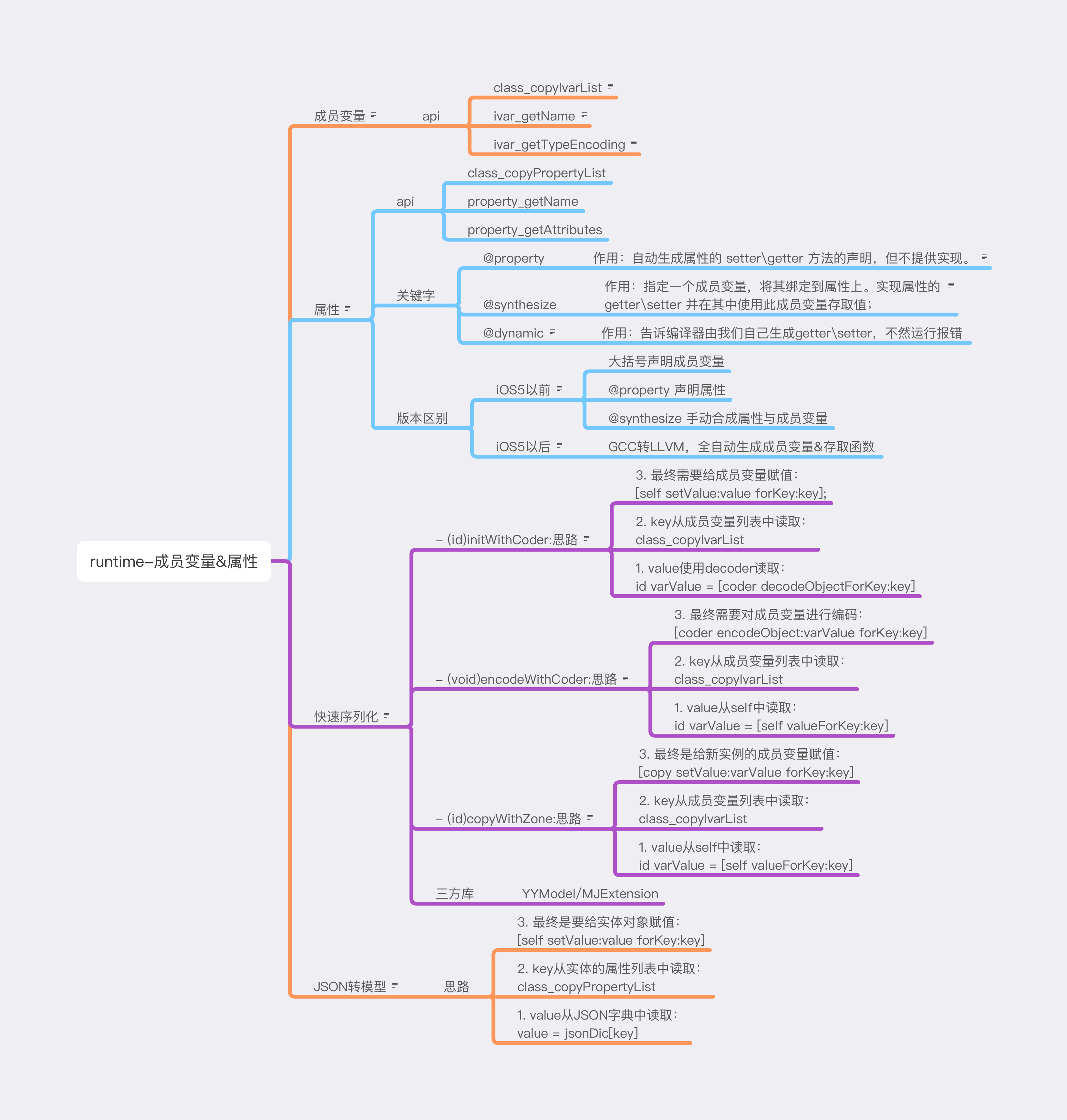1.成员变量 Ivar 在objc/runtime.h中,Ivar的描述如下:
1 2 3 4 5 6 7 8 9 10 11 typedef struct objc_ivar *Ivar;struct objc_ivar {char *ivar_namechar *ivar_typeint ivar_offset#ifdef __LP64__ int space#endif
Ivar,对象的成员变量,是一个指向objc_ivar结构体的指针,包括名字与类型。
获取成员变量 常用操作函数有:
1 2 3 4 5 6 7 8 9 10 11 12 13 14 15 16 17 // 获取所有成员变量// 获取成员变量名// 获取成员变量类型编码// 获取指定名称的成员变量// 获取某个对象成员变量的值// 设置某个对象成员变量的值
2.属性 属性的定义 1 2 typedef struct objc_property *objc_property_t ;
属性,一个指向objc_property结构体,通常以@property关键字来声明。
属性与成员变量是两个独立的结构体,但两者被紧紧关联在了一起,只不过在不同版本的编译器中稍有不同。
iOS5以前,使用属性通常需要三步:
大括号声明成员变量;
@property 声明属性;
@synthesize 手动合成属性与成员变量;
#示例:
1 2 3 4 5 6 7 8 9 10 11 12 13 14 15 16 17 18 19 20 21 22 @interface People ()NSString *_name;NSString *nick;@property (nonatomic ,copy ) NSString *name;@property (nonatomic , copy ) NSString *aliasName;@end @implementation People @synthesize name = _name;@synthesize aliasName = nick;void )test{self .name = @"A" ;self .aliasName = @"B" ;NSLog (@"++self.name='%@',++self.aliasName='%@',++_name='%@',++nick='%@'" ,self .name,self .aliasName,_name,nick);@end
1.示例中{ }里声明成员变量时可以使用下划线_开头,也可以不带下划线;
2.@property的作用是自动生成属性的 setter\getter 方法的声明,即
1 2 - (void)setName:(NSString*)aName;- (NSString*)name;
3.@synthesize的作用是指定一个成员变量,将其绑定到属性上。然后实现属性的 getter\setter 并在其中使用此成员变量存取值;
1 2 3 4 5 6 7 8 9 10 - (NSString *)name {_name ;setName :(NSString *)aName{if (aName && _name && ![aName isEqualToString:_name ]) {_name = aName;
在iOS5以后,苹果将编译器从 GCC 转为 LLVM,以 @property 声明的属性name,编译器会默认为其生成一个以下划线开头的成员变量,同时实现 setter/getter 方法并在其中使用"_name"存取值,所以编译器帮我们省去了部分操作。 在.m文件中,我们可以直接使用_name,也可以使用self.name。其中,后者实际上是调用了属性name的 getter\setter 函数。
ps: iOS5之后,@synthesize仍可以继续使用。如果@synthesize后为属性指定的这个成员变量并不存在,那么编译器会自动帮我们创建一个新的同类型的成员变量。例如@synthesize aliasName = NotExistIvar;,我们的{ }中并未声明此成员变量NotExistIvar,编译器会自动帮我们创建~
获取属性 属性的常用操作函数:
1 2 3 4 5 6 7 8 9 10 11 // 获取所有属性// 获取属性名// 获取属性特性描述字符串// 获取所有属性特性
其中,property_getAttributes返回的是一个objc_property_attribute_t结构体列表:
1 2 3 4 5 typedef struct {const char *name; const char *value; objc_property_attribute_t ;
常用的值如下:
1 2 3 4 属性类型 name值:T value:NSString 等copy )、&(strong \retain )、W(weak )、R(readonly )、空(assign ) 等 value:无
3.查询示例 1 2 3 4 5 6 7 8 9 10 11 12 13 14 15 16 17 18 19 @interface IvarTool : NSObject double ivar_defaultDouble;@package int ivar_packInt;@public float ivar_publicFloat;@protected NSString *ivar_protectedStr;@private NSDictionary *ivar_privateDic;@property (nonatomic ,copy ) NSString *property_string;void )ivarList;void )propertyList;@end
1 2 3 4 5 6 7 8 9 10 11 12 13 14 15 16 17 18 19 20 21 22 23 24 25 26 27 28 29 30 31 32 33 34 35 36 37 38 39 40 41 42 43 44 45 46 47 48 49 #import "IvarTool.h" #import <objc/runtime.h> @interface IvarTool ()int ivar_int;@public NSArray *ivar_array;@property (nonatomic , strong ) NSDictionary *property_dic;@end @implementation IvarTool void )ivarListunsigned int count = 0 ;class ], &count);for (int i = 0 ; i<count; i++)const char *charName = ivar_getName(ivar);const char *charType = ivar_getTypeEncoding(ivar);NSLog (@"Name:%s,Type:%s" ,charName,charType);void )propertyListunsigned int count = 0 ;class ], &count);for (int i = 0 ; i<count; i++)const char *charName = property_getName(aProperty);const char *charType = property_getAttributes(aProperty);NSLog (@"Name:%s,Type:%s" ,charName,charType);@end
调用[IvarTool ivarList],查看成员变量,输出日志如下:
1 2 3 4 5 6 7 8 9 Name :ivar_defaultDouble,Type :dName :ivar_packInt,Type :iName :ivar_publicFloat,Type :fName :ivar_protectedStr,Type :@"NSString"Name :ivar_privateDic,Type :@"NSDictionary"Name :ivar_int,Type :iName :ivar_array,Type :@"NSArray"Name :_property_string,Type :@"NSString"Name :_property_dic,Type :@"NSDictionary"
调用[IvarTool propertyList],查看属性列表,输出日志如下:
1 2 Na me:pr operty_dic,Type:T @"NSDictionary" ,&,N ,V_property_dicNa me:pr operty_string,Type:T @"NSString" ,C,N ,V_property_string
小结 :
编译器会自动为属性生成对应的以下划线开头的成员变量;
无论成员变量的访问权限如何,是在.h 还是 .m 中声明的,class_copyIvarList 都能获取的到;
无论属性定义在 .h 还是 .m 中,class_copyPropertyList 能获取全部属性;
class_copyIvarList 与 class_copyPropertyList 都只能获取到当前类中定义的成员变量或属性,获取不到其父类的中定义的;
4.访问权限 关于成员变量的访问权限,Apple官方 描述如下:
@public: 导入头文件的地方,都能直接访问(.m文件中声明的成员变量除外);
@protected: 本类及其子类实例方法中可见;
@private: 只对本类可见,对其子类不可见;
@package: 比较特殊,访问范围介于public和private之间,只要处于同一个镜像或可执行文件中时相当于public,在实现其的镜像或可执行文件之外时相当于private,下面是Apple原文中的描述;
Using the modern runtime, an @package instance variable has @public scope inside the executable image that implements the class, but acts like @private outside.
默认值:
.h中默认为 @protected;
.m中默认为 @private;
#示例:
1 2 3 4 5 6 7 8 9 10 11 12 13 14 15 16 17 18 19 20 - (BOOL)application:(UIApplication *)applicationtool ->tool ->tool ->tool ->tool ->tool ->tool ->
若想实现成员变量支持外部访问,需要在头文件的声明中给该成员变量添加@public修饰符,同时在外部访问时使用->。m文件内即使成员变量添加@public修饰符,外部访问时仍会报错,因为它只对m文件内可见。
5.快速序列化 原理:利用runtime提供的函数,遍历model的属性,并对属性进行decode与encode。
#示例:
1 2 3 4 5 6 7 8 9 10 11 12 13 14 15 16 17 18 19 20 21 22 23 24 25 26 27 28 29 30 31 32 33 34 35 36 37 38 39 40 41 42 43 44 45 46 47 48 49 50 51 52 53 54 55 56 57 58 59 60 61 62 63 64 65 66 67 68 69 70 71 72 73 74 75 76 77 78 79 80 81 82 83 84 85 86 87 88 89 90 91 92 93 94 95 96 97 98 99 100 101 102 103 104 105 106 107 108 109 110 //ModelSerialiseHelper.hdefine ModelSerialiseHelper_h1 、TLObject头文件中声明NSCoding协议@interface TLObject : NSObject<NSCoding>@property (nonatomic, copy) NSString *mName@property (nonatomic) BOOL mIsTrue@property (nonatomic) NSInteger mInteger@property (nonatomic) UIImage *mImage@end 2 、m文件中导入头文件和宏即可"TLObject.h" "ModelSerialiseHelper.h" @implementation TLObject@end define ModelCodingProtocol()\= [self class]= [NSObject class])\= 0 = class_copyIvarList([cls class], &count)= 0 = ivar_getName(*(ivarList + i))= [NSString stringWithUTF8 String:varName]= [key substringToIndex:1 ]"_" ]) {\= [key substringFromIndex:1 ]= [coder decodeObjectForKey:key]free (ivarList)= class_getSuperclass(cls)= [self class]= [NSObject class])\= 0 = class_copyIvarList([cls class], &count)= 0 = ivar_getName(*(ivarList + i))= [NSString stringWithUTF8 String:varName]= [key substringToIndex:1 ]"_" ]) {\= [key substringFromIndex:1 ]= [self valueForKey:key]free (ivarList)= class_getSuperclass(cls)define ModelCopyProtocol()\= [[[self class] allocWithZone:zone] init]= [self class]= [NSObject class])\= 0 = class_copyIvarList([cls class], &count)= 0 = ivar_getName(*(ivarList + i))= [NSString stringWithUTF8 String:varName]= [key substringToIndex:1 ]"_" ]) {\= [key substringFromIndex:1 ]= [self valueForKey:key]free (ivarList)= class_getSuperclass(cls)
上述代码为ModelSerialiseHelper.h,其中:
ModelCopyProtocol() 封装了copy协议的相关实现代码;
ModelCodingProtocol() 封装了encode和decode的相关代码;
在需要实现这两个协议的model中,导入ModelSerialiseHelper.h并引用上述两个宏定义即可。
6.json字典转Model 原理:获取模型的属性列表,通过kvc从字典中取值并赋值给对应的属性字段。
#示例:
1 2 3 4 5 6 7 8 9 10 11 12 13 14 15 16 17 18 19 20 21 22 23 24 25 26 27 28 29 30 31 32 33 34 35 36 37 38 39 40 #import "NSObject+JsonToModel.h" #import <objc/runtime.h> @implementation NSObject (JsonToModel )instancetype )initModelWithDictionary:(NSDictionary *)jsonDicif (self = [self init])NSMutableArray * keysArr;if (!jsonDic) {return nil ;NSMutableArray array];unsigned int count;self class ], &count);for (int i = 0 ; i < count; i++)const char *charName = property_getName(property);NSString *propertyName = [NSString stringWithCString:charName encoding:NSUTF8StringEncoding ];if (propertyName.length) {for (NSString * key in keysArr) {self setValue:jsonDic[key] forKey:key];return self ;@end
调用示例:
1 2 NSDictionary * dic = @{ @"name": @"xxx", @"sex": @(1), @"age": @(20)}; * person = [[PersonModel alloc] initModelWithDictionary:dic];
这里的示例只是一个简单的场景,实际应用中可能会有更复杂的需求,视情况做响应修改即可。
相关参考:
#©Apple
